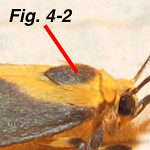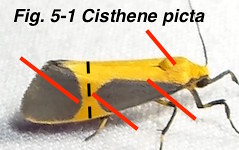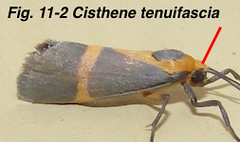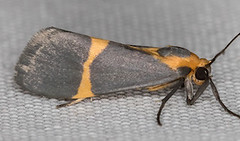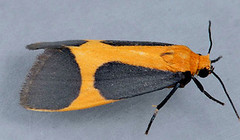ID Guide 3: Artificial Key to Cisthene lichen moths (Noctuidae, Arctiinae, Lithosiini) of Texas - Introduction
Over the past few weeks, I have made a long-overdue attempt to learn the small and confusing gray-and-orange lichen moths in the genus Cisthene. Twenty species are known from North America, and at least 12 species have been reported in Texas. The latter seemed like a good group to start out with; there are several additional species to be dealt with in FL, AZ, and the Pacific Coast, but that's for another day. I have found that even though many of the Cisthene species are quite variable, standard descriptions of the common patterns of each species can be constructed which will serve to identify the vast majority of moths (contra Knowlton, 1967), at least among the Texas fauna. Range is also important, and broad habitat and biogeographical considerations should not be ignored. This journal entry provides an introduction to the "Artificial Key" that I have created for the 12 Texas species. An artificial key is a dichotomous key which helps separate species without regard to their actual phylogenetic relationships.
I reviewed readily available (online) literature, including original descriptions, and studied online images from Barcode of Life Database (BOLD), Moth Photographer's Group (MPG), BugGuide (BG), iNaturalist, and other sources, along with my own collection of photos. None of these sources has been error-free. I relied primarily on barcoded specimens and those vetted by genitalic examination and recognized experts to assess color patterns.
The twelve species of Cisthene which have been reported in Texas are (with Hodges numbers and original authors):
#8059 Cisthene subrufa (Barnes & McDunnough, 1913)
#8060 Cisthene unifascia Grote & Robinson, 1868
#8061 Cisthene kentuckiensis (Dyar, 1904)
#8066 Cisthene tenuifascia Harvey, 1875
#8067 Cisthene plumbea Stretch, 1885
#8070 Cisthene angelus (Dyar, 1904)
#8071 Cisthene subjecta Walker, 1854
#8072 Cisthene packardii (Grote, 1863)
#8073 Cisthene conjuncta (Barnes & McDunnough, 1913)
#8074 Cisthene barnesii (Dyar, 1904)
#8075 Cisthene picta (Barnes & McDunnough, 1918)
#8078 Cisthene martini C.B. Knowlton, 1967
Important Features of Adult Cisthene Moths for Identification Purposes
Critical to identification of photographic records are a combination of both lateral and dorsal images and an image with a mm rule wherever possible. An understanding of the structure of the adult moth is also crucial to descriptions of Cisthene as is a general agreement on the names of colors. Below, I highlight those portions of the moths that I emphasize in the key in a subsequent journal entry. First I'm embedding a set of photos of various Cisthene species to illustrate most of the common features I use in the identification key:

Figure 1. Cisthene tenuifascia: Useful Characters for Identification of Cisthene moths.

Figure 2. An example of Cisthene packardii, showing additional features used in the identification key.
(Photo credit: @royaltyler, from iNaturalist)

Figure 3. An example of Cisthene plumbea, showing additional features used in the identification key.

Figure 4. Cisthene nr. subrufa, showing additional features used in the idenfication key.
Head. The head only occasionally provides useful information in a macroscopic examination of a Cisthene specimen or photograph. Particular attention should be paid to the vertex, i.e., the top of the head between the eyes and in front of the collar (see next).
Thorax. The collar is a narrow rectangular band of scales covering the front of the thorax (e.g. the "neck"); it is often colored similar to the bands on the forewings. Most Cisthene show a dark oval central disk on top of the thorax between the base of the wings. A few species are distinctive in having this disk entirely orange. Flanking the disk are the tegulae (singular: tegula) which are usually colored with the same yellow or orange color as seen on the forewings.
Forewings. Many useful characters which help distinguish adult Cisthene moths are viewed on the forewings (FWs), particularly in a side view of a live specimen. On such a specimen, the inner (or rear) margin of the FWs is on top where the wings meet. The costal margin is the "forward" edge of the wings, i.e., the lower edge on a perched moth. The dark ground color varies from black or dark gray to dark gray-brown and provides useful information in just a few species. More important are the colored stripes, bands, and spots on the FWs. These include:
-- Basal streak. Almost all Cisthene have some kind of colored band along the inner margin of the FWs (the top edge on a living specimen with folded wings). It's width and color are useful in many cases, as is its connection (or lack thereof) to the postmedian color band, or its separation from the inner FW margin by gray.
-- Postmedian band (PM band). This band of color crosses the wing just beyond the middle, extending in most instances from the inner margin down to the costal margin (lower edge on the folded wing). It is quite variable in shape in many species: It may be wide or narrow and is typically flared out at both the top and bottom ends. It's orientation, perpendicular to the inner margin or paralleling the outer FW margin, is sometimes important. In some species this band is very narrow and broken into just two or three thin spots. In a few species it consists of only two colored PM spots (semicircles or triangles) on the inner and costal margins or just a single spot on the inner margin. While variable, this band, in combination with the basal streak, provides crucial information in most species.
-- Costal margin. Away from the costal PM band or spot, most species show only the dark ground color along the costal margin. However, a few species characteristically show an extensive but narrow yellow margin along the costa which can be useful for identification.
Hindwings. Most Cisthene have a red, pink, or yellow hindwing with a variable amount of dusky gray color near the apex (outer corner) or outer margin. However, since this is rarely visible in photos of living specimens, I don't emphasize it in the present key. There are important differences among species (and even subgenera) in the shape and scaling on the anal angle (inner corner near the abdomen) on males; for these differences, the reader should consult Knowlton's 1967 review of the genus.
Legs. The legs of almost all Cisthene are blackish with varying and variable amounts of color (orange or yellow) on the base of the middle femur and sometimes other segments. These are so variable as to be of almost no use in field identification. As a general rule, however, the more yellow or orange color on the FWs, the more color there is on the legs.
I try to use common color names familiar to a contemporary reader. The ground color on all species will be some shade of slate gray, but ranging from brownish gray to nearly black; this is important for identification in a few species. The remaining "color" areas of the body and wings are various shades of orange, ranging from yellow to red-orange, but with a few important exceptions.
Subsequent parts of this multiple-entry journal article will include (a) the identification key and (b) a set of more complete species descriptions. I am also preparing a series of maps which will bring together (verifiable) records from several sources including original literature, BOLD, MPG, BugGuide, iNaturalist, and other sources.
NOTE: This should be considered a DRAFT publication. I retain all rights to its content and subsequent publication. Please contact me (iNat message) for further details about development of the full article (in prep.).
References: (A more complete list of references and literature is in preparation.)
Holland, W. J. 1903 (1968 Dover reprint). The Moth Book. Dover Publ., New York. [Key to seven spp. of "Illice" (= Cisthene) on p. 109.]
Knowlton, Carroll B. A Revision of the Species of Cisthene Known to Occur North of the Mexican Border (Lepidoptera: Arctiidae: Lithosiinae). Trans. of the Amer. Entom. Soc., Vol. 93, No. 1 (Mar., 1967), pp. 41-100. Link to pdf copy available on BugGuide: http://bugguide.net/node/view/790908
Knudson, Ed, and Charles Bordelon. Checklist of the Lepidoptera of Texas, 2010 ed. Texas Lep. Soc. Publ. No. 6.
Lafontaine, J. Donald, and B. Christian Schmidt. Annotated check list of the Noctuioidea (Insecta, Lepidoptera) of North America north of Mexico. ZooKeys 40:1-239 (2010). Link to pdf copy on BugGuide: http://bugguide.net/node/view/601000
Powell, Jerry A., and Paul A. Opler. Moths of Western North America. Univ. of Calif. Press, Berkeley (2009), 369 pp.








